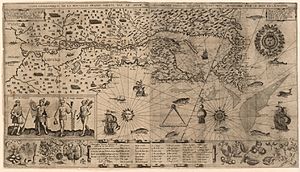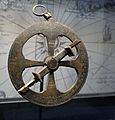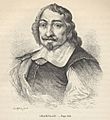Samuel de Champlain facts for kids
Quick facts for kids
Samuel de Champlain
|
|
|---|---|
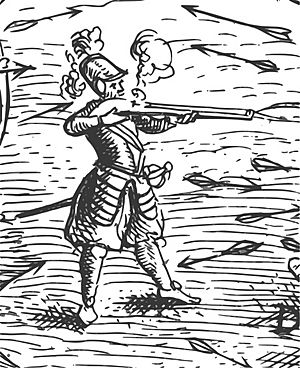
Detail from "Deffaite des Yroquois au Lac de Champlain," from Champlain's Voyages (1613). This is the only contemporary likeness of the explorer to survive to the present. It is also a self-portrait.
|
|
| Born | between 1567 and 1580 (most probably near 1580) Brouage, Province of Saintonge, France
|
| Died | December 25, 1635 |
| Occupation | navigator, cartographer, soldier, explorer, sailor, administrator and chronicler of New France |
| Known for | exploration of New France, foundation of Quebec City, Canada, being called The Father of New France |
| Signature | |
Samuel de Champlain (born between 1567 and 1580 – died December 25, 1635) was a French explorer and mapmaker. He was also a soldier, sailor, and writer. He made many trips across the Atlantic Ocean.
Champlain is famous for founding Quebec City in New France on July 3, 1608. He is often called "The Father of New France". In 1609, he explored a large lake that was later named Lake Champlain after him.
Contents
Early Adventures
Samuel de Champlain was born in Brouage, France. We don't know much about his early life. Some people think his mother was a Huguenot, a French Protestant.
His first trip to North America was on March 15, 1603. He joined an expedition that was trading furs. Even though he didn't have an official job on the trip, he drew a map of the St. Lawrence River. When he returned to France on September 20, he wrote a book about his travels called Des Sauvages (The Savages).
King Henry IV asked Champlain to report on his discoveries. So, Champlain joined another trip to New France in the spring of 1604. This trip was led by Pierre Du gua Sieur de Monts. Champlain helped start the Saint Croix Island settlement. The settlers moved in the spring of 1605 to found the Habitation at Port-Royal. Champlain lived there until 1607, exploring the Atlantic coast.
In 1605 and 1606, Champlain explored the area that is now Chatham, Cape Cod. He thought about making a settlement there. But small fights with the local Monomoyick Indians changed his mind. He named the area Port Fortune and put it on his maps.
Founding Quebec City
On July 3, 1608, Champlain arrived at a place he called the "point of Quebec." He started building defenses there. He built three main buildings, each two stories tall. He also dug a moat that was 15 feet wide. This place would become the city of Quebec. Protecting Quebec City, which he called his "Habitation," became a very important task for him for the rest of his life.
The first winter was very hard for the settlers. Out of twenty-five people who stayed, only 8 survived. Most of them died from scurvy and some from smallpox.
Family Life
Champlain married Hélène Boullé on December 27, 1610.
Hélène lived in Quebec for a few years. Later, she went back to Paris and decided to join a convent. The couple did not have any children of their own. However, Champlain adopted three Montagnais girls in the winter of 1627–28. He named them Faith, Hope, and Charity.
Relations with Native Peoples
In the summer of 1608, Champlain worked to build good relationships with the local Native American groups. He made friends with the Huron and Algonquins. These groups lived north of the St. Lawrence River. Champlain promised to help them in their war against the Iroquois.
Champlain set off with 9 French soldiers and 300 Native Americans. They explored the Rivière des Iroquois, which is now the Richelieu River. This is when he discovered Lake Champlain. Many men went back because they hadn't found any Iroquois. Champlain continued with only 2 Frenchmen and 60 Native Americans.
On July 29, at Ticonderoga, Champlain and his group met a group of Iroquois. A battle started the next day. Two hundred Iroquois came towards Champlain's position. A native guide pointed out the three Iroquois chiefs. Champlain fired his arquebus (a type of gun) and killed two chiefs with one shot. The Iroquois turned and ran away. This battle shaped the relationship between the French and the Iroquois for the next one hundred years.
After his victory, Champlain went back to France. He tried to get his fur trade monopoly renewed, but he failed. However, he formed a new partnership with merchants from Rouen. Quebec would become a special storage place for their fur trade. In return, the Rouen merchants would support the settlement. Champlain returned to Quebec on April 8, 1610.
Securing New France
In the summer of 1611, Champlain traveled to the area that is now Montreal. He cleared the land and built a wall to see how it would last through the winter. To gain more respect from the native peoples, he went through the Lachine Rapids with them. Only one other European had ever done this before.
That fall, he went back to France again to secure the future of his project in the New World. He had lost the support of the merchants in 1610. So, he wrote a letter to King Louis XIII asking for his help.
On October 8, 1612, King Louis XIII named Charles de Bourbon, comte de Soissons as his main representative in New France. Charles died soon after, and Henry II, Prince of Condé took his place. Champlain was given the title of lieutenant. This meant he could lead in the king's name. He could appoint officers, make laws, sign treaties, and fight wars with native groups. He also had to find the easiest way to China and the East Indies. And he had to find and use mines of precious metals in the area.
Exploring New France
At the start of the year, Champlain published a book about his life from 1604-1612 called Voyages. On March 29, 1613, he arrived back in New France and announced his new role. Champlain set out on May 27 to keep exploring the Huron country. He hoped to find the 'northern sea' he had heard about, which was probably Hudson Bay. He traveled along the Ottawa River and wrote the first description of this area. In June, he met Tessouat, the Algonkian chief of Allumette Island. Champlain offered to build them a fort if they moved from their poor land to the Lachine Rapids.
By August 26, Champlain was back in Saint-Malo, France. There, he wrote about his journey up the Ottawa River. He also published another map of New France. In 1614, he formed two companies: the "Compagnie des Marchands de Rouen et de Saint-Malo" and "Compagnie de Champlain." These companies brought together merchants for eleven years. He returned to New France in the spring of 1615. This time, he brought four Recollects (religious people) to help with religious life in the new colony.
Champlain continued to work on improving relations with the native peoples. He promised to help them in their fights against the Iroquois. With his native guides, he explored further up the Ottawa River and reached Lake Nipissing. Then he followed the French River until he reached a large freshwater lake he called Lac Attigouautau, which is now Lake Huron.
In 1615, Champlain was guided through the Peterborough area by the Huron. He used an old path between Chemong Lake and Little Lake. He stayed for a short time in the Bridgenorth area.
Military Expedition
On September 1, at Cahiagué (on Lake Simcoe), Champlain began a military expedition. They crossed Lake Ontario at its eastern end. They hid their canoes and continued their journey by land. They followed the Oneida River until they found an Iroquois fort. The Hurons pressured them to attack too early, and the attack failed. Champlain was wounded twice in the leg by arrows, one in his knee. The attack lasted three hours until they were forced to escape.
Even though he didn't want to, the Hurons insisted that Champlain spend the winter with them. During his stay, he went with them on a big deer hunt. He got lost and had to wander for three days, living off game and sleeping under trees. He met a group of Native Americans by chance. He spent the rest of the winter learning about "their country, their manners, customs, modes of life." On May 22, 1616, he left the Huron country. He was back in Quebec on July 11 before heading back to France on July 20.
Improving New France
Champlain returned to New France in 1620. For the rest of his life, he focused on managing the colony rather than exploring.
In early July 1628, supplies were running low. A war had started between France and England. Charles I of England had given permission to capture French ships and colonies in North America.
On July 19, Champlain had to surrender the colony. Many settlers were taken first to England and then to France. But Champlain stayed in London to start the process of getting the colony back. It wasn't until the 1632 Treaty of Saint-Germain-en-Laye that Quebec was officially given back to France.
Later Life and Death
By October 1635, Champlain became very ill and was paralyzed. He died on December 25, 1635. He was temporarily buried in an unmarked grave while a chapel was being built. Sadly, this chapel was destroyed by fire in 1640 and rebuilt right away. But nothing is known about it after 1640, and it no longer existed after 1674. Because of this, the exact place where Champlain is buried is unknown.
There is no true portrait of Champlain. Paintings that were thought to be of Champlain have been shown to be of someone else, Michel Particelli d’Émery. The only picture we have that might show him is an engraving of a battle at Lake Champlain in 1609. But the faces are too unclear to tell for sure.
Legacy and Memorials
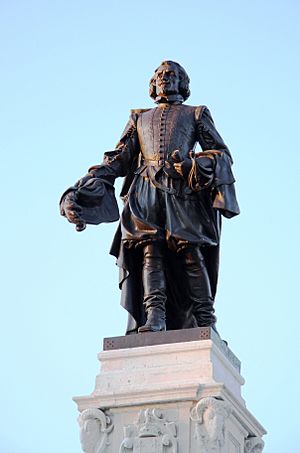
Many places and landmarks are named after Champlain. He was a very important person in many parts of Acadia, Ontario, Quebec, New York, and Vermont. He is remembered as the "Father of New France" and "Father of Acadia." His historical importance continues today.
Lake Champlain is a large lake that crosses the border between northern New York and Vermont, and goes a little into Canada. Champlain named it in 1609. He led an expedition along the Richelieu River and explored this long, narrow lake. It is located between the Green Mountains of present-day Vermont and the Adirondack Mountains of present-day New York. Champlain was the first European to map and describe it, and he claimed the lake as his namesake.
Memorials include:
- Lake Champlain, the Champlain Valley, and the Champlain Trail Lakes.
- Champlain Sea: This was a large inlet of the Atlantic Ocean in North America. It covered areas over the St. Lawrence River, the Saguenay River, and the Richelieu River, extending over Lake Champlain. This inlet disappeared thousands of years before Champlain was born.
- Champlain Mountain, in Acadia National Park. Champlain first saw this mountain in 1604.
- A town and village in New York. Also, a township in Ontario and a municipality in Quebec.
- The provincial voting district of Champlain, Quebec. There were also several other voting districts in Canada that no longer exist.
- Samuel de Champlain Provincial Park, a provincial park in northern Ontario near the town of Mattawa.
- Champlain Bridge, which connects the island of Montreal to Brossard, Quebec, across the St. Lawrence River.
- Champlain Bridge, which connects the cities of Ottawa, Ontario, and Gatineau, Quebec.
- Champlain College, one of six colleges at Trent University in Peterborough, Ontario, is named in his honor.
- Fort Champlain, a dormitory at the Royal Military College of Canada in Kingston, Ontario. It was named in his honor in 1965.
- A French school in Saint John, New Brunswick; École Champlain, an elementary school in Moncton, New Brunswick; Champlain College, in Burlington, Vermont; and Champlain Regional College, a CEGEP with three campuses in Quebec.
- Marriott Château Champlain hotel, in Montreal.
- Streets named Champlain in many cities. These include Quebec, Shawinigan, the city of Dieppe in New Brunswick, in Plattsburgh, and at least eleven communities in northwestern Vermont.
- A garden called Jardin Samuel-de-Champlain in Paris, France.
- A memorial statue on Cumberland Avenue in Plattsburgh, New York, on the shores of Lake Champlain. It is in a park named for Champlain.
- A memorial statue in Saint John, New Brunswick, Canada, in Queen Square. It remembers his discovery of the Saint John River.
- A memorial statue in Isle La Motte, Vermont, on the shore of Lake Champlain.
- The lighthouse at Crown Point, New York has a statue of Champlain by Carl Augustus Heber.
- A commemorative stamp was issued in May 2006 by the United States Postal Service and Canada Post.
- A statue in Ticonderoga, New York, unveiled in 2009. It marked the 400th anniversary of Champlain's exploration of Lake Champlain.
- A statue in Orillia, Ontario, at Couchiching Beach Park on Lake Couchiching. This statue was removed by Parks Canada. It is not likely to be returned because it showed offensive images of First Nations peoples.
- HMCS Champlain (1919), a type of destroyer ship that served in the Royal Canadian Navy from 1928 to 1936.
- HMCS Champlain, a Canadian Forces Naval Reserve division based in Chicoutimi, Quebec since 1985.
- Champlain Place, a shopping center located in Dieppe, New Brunswick, Canada.
- The Champlain Society, a Canadian historical society that publishes texts. It was started in 1927.
- A memorial statue in Ottawa at Nepean Point, by Hamilton MacCarthy. The statue shows Champlain holding an astrolabe (a tool for navigation), but it is upside-down. It used to include an "Indian Scout" kneeling at its base. In the 1990s, after requests from Indigenous people, it was removed from the statue's base. It was renamed "Anishinaabe Scout" and placed in Major's Hill Park.
Images for kids
-
Sir Sandford Fleming Park, Halifax, Nova Scotia – Stone from Samuel de Champlain's birthplace in Brouage, France (1574)
-
Champlain and guide in Isle La Motte, Vermont, at the site Champlain is said to have first set foot in Vermont (and encamped) in 1609. Lake Champlain is in the background. (Sculptor E.L.Weber, 1967; Photo by Matt Wills, 2009)
-
Plaque in Honfleur commemorating Champlain's departures
-
Painting by George Agnew Reid, done for the third centennial (1908), showing the arrival of Samuel de Champlain on the site of Quebec City.
-
Chaleur Bay and Gulf of Saint Lawrence — extract of Champlain 1612 map
-
Samuel de Champlain, Nepean Point, Ottawa by Hamilton MacCarthy
See also
 In Spanish: Samuel de Champlain para niños
In Spanish: Samuel de Champlain para niños


